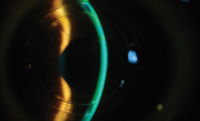 Q: With collagen cross-linking for ectasias (especially keratoconus), is there a different level of safety regarding the endothelial’s UV absorption in epithelium-on vs. epithelial removal treatment?
Q: With collagen cross-linking for ectasias (especially keratoconus), is there a different level of safety regarding the endothelial’s UV absorption in epithelium-on vs. epithelial removal treatment?
A: Damage to tissues that undergo corneal collagen cross-linking using riboflavin and UVA light has been documented, and is associated with the UVA portion of the treatment. The corneal stroma acts as a filter of UV light that can be harmful to the endothelium. Unfortunately, there is more than a tenfold increase in toxicity when combined with riboflavin.1
“The success of the treatment to induce cross-linking in the corneal stroma is excellent, while phototoxicity to the corneal endothelium is an undesirable potential side effect,” says Andrew S. Morgenstern, O.D., president of the recently formed Optometric Cross-Linking Society.
Whether your patient is dealing with keratoconus, post-RK instability or post-refractive surgery ectasia, “based on all of the literature that I have read and in my personal experience, the endothelial safety level up to date has been based on the overall corneal thickness anterior to endothelium,” Dr. Morgenstern says.
The endothelium reaches a cytotoxic level in response to combined treatment with riboflavin and UVA at 0.35mW/cm2. In a 400µm thick cornea with riboflavin saturation, just 6% of the initial energy is distributed to the endothelium. Considering that most instruments have an output of 3mW/cm2, typically the level would reach only 0.18mW/cm2.

This keratoconic cornea (with prior insertion of Intacs) glows green from riboflavin application during epithelium-on collagen cross-linking. Photo: Andrew Morgenstern, O.D.
“In an epithelium-off procedure, so long as the corneal thickness is maintained above 400µm, the relative risk is quite low,” says Scott G. Hauswirth, O.D., vice president of OCXLS. “When there is ample tissue for the UVA light to filter through, the toxic levels of UVA light that pass to the endothelium are rendered safe.”
Some clinicians even remove the epithelium on a thin cornea so they have the ability to swell the remaining tissue to provide ample safety and protection to the endothelium. The relative risk to the endothelium in an epithelium-on procedure is even less, as the corneal epithelium also absorbs UV light and can lower the energy level.2
“Based on evidence in various studies, as long as the procedure is done within the parameters outlined in their respective clinical trial outlines—with respect to corneal pachymetry––there seems to be no evidence of long-term endothelial damage,” Dr. Morgenstern says.
Corneal collagen cross-linking currently is not FDA approved, but device manufacturers are pursuing indications.
1. Wollensak G, Spoerl E, Seiler T. Riboflavin/ultraviolet-a-induced collagen crosslinking for the treatment of keratoconus. Am J Ophthalmol. 2003;135:620-7.
2. Bottos KM, Schor P, Dreyfuss J, et al. Effect of corneal epithelium on ultraviolet-A and riboflavin absorption. Arq Bras Oftalmol. 2011;74(5):348-351.
For more information on cross-linking procedures, visit the new Optometric Cross-Linking Society (OCXLS) website at
www.ocxls.org.

